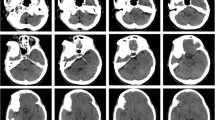Abstract
The cavernous hemangioma is the most common benign orbital tumor in adults. Its presentation is during the forth to fifth decades with a slowly progressive unilateral proptosis. Intraconal cavernous hemangiomas may be difficult to differentiate from other intraconal lesions such as schwannomas, meningiomas and hemangiopericytomas. We report a case of orbital cavernous hemangioma diagnosed by Tc-99m RBC scintigraphy. Tc-99m RBC scintigraphy revealed a typical scintigraphic pattern in which there is intense focally increased uptake on the delayed image. We conclude that Tc-99m RBC scintigraphy can be a useful method in the differential diagnosis of orbital cavernous hemangioma as in hepatic hemangioma.
Similar content being viewed by others
References
Kanski JJ. Disorders of the Orbit. InClinical Ophthalmology, Kanski JJ (ed), 4th ed, Oxford; Butterworth-Heinemann, 1999: 551–584.
Mafee MF. Imaging of the orhit. InImaging of the Head and Neck, Valvassori GE (ed), New York: Thieme Medical Publishers, 1995: 193–199.
Fries PD, Char DH, Norman D. MR imaging of orbital cavernous hemangioma.J Comput Assist Tomogr 1987; 11: 418–421.
Mafee MF, Putterman A, Valvassori GE, Campos M, Capek V. Orbital space occupying lesions: role of CT and MRI, an analysis of 145 cases.Radiol Clin North Am 1987; 25: 529–559.
Wilms G, Ratt, H, Dom R, Thywissen C, Demaerel P, Dralands G, et al. Orbital cavernous hemangioma: findings on sequential Gd-enhanced MRI.J Comput Assist Tomogr 1995; 19: 548–551.
Mafee MF. Eye and orbit. InHead and Neck Imaging, Som PM (ed), St. Louis; Mosby, 1996: 1109–1114.
Groshar D, Ben-Haim S, Gips S, Hardoff R, Jerushalmi J, Parmett S, et al. Spectrum of scintigraphic appearance of liver hemangiomas.Clin Nucl Med 1992; 17: 294–299.
Middleyon ML. Scintigraphic evaluation of hepatic mass lesions: emphasis on hemangioma detection.Semin Nucl Med 1996; 26: 4–15.
Rabowitz SA, McKusick KA, Strauss HW. Tc-99m Red Blood Cell Scintigraphy in Evaluating Focal Liver Lesions.AJR 1984; 143: 63–68.
Rubin RA, Lichtenstein GR. Scintigraphic evaluation of liver masses: cavernous hepatic hemangioma.J Nucl Med 1993; 34: 849–852.
Murata Y, Yamada I, Umehara I, Ishii Y, Okada N: Perfusion and blood-pool scintigraphy in the evaluation of head and neck hemangiomas.J Nucl Med 1997; 38: 882–885.
Barton DJ, Miller JH, Allwright SJ, Sloan GM. Distinguishing soft-tissue hemangiomas from vascular malformations using technetium-labeled red blood cell scintigraphy.Plast Reconstr Surg 1992; 89: 46–52.
Murata Y, Yamada I, Umehara I, Shibuya H. The use of three-phase scintigraphy for diagnosing hemangiomas of the extremities.Clin Nucl Med 1997; 22: 372–375.
Phillpot J, Ali SA, Briscoe EG, Cesani F. Three-phase Tc-99m RBC scintigraphy of a splenic hemangioma.Clin Nucl Med 1997; 22: 158–160.
Deol AK, Terry TE, Seibert DA, Solanki HP, Chertow BS. Hemangioma of the apical orbit diagnosed by radionuclide imaging.Optom Vis Sci 1994; 71: 57–59.
Ki WW, Shin JW, Won KS, Ryu JS, Yang SO, Lee HK, et al. Diagnosis of orbital cavernous hemangioma with Tc-99m RBC SPECT.Clin Nucl Med 1997; 22: 546–549.
Gdal-On M, Gelfand YA, Israel O. Tc-99m labeled red blood cell scintigraphy (Tc-99m RBC scintigraphy) as a diagnostic method for orbital cavernous hemangioma.Eur J Ophthalmol 1999; 9: 125–129.
Wilson MA. Gastrointestinal Tract. InTextbook of Nuclear Medicine, Wilson MA (ed), Philadelphia, Lippincott-Raven Publishers, 1998: 57–88.
Orcutt JC, Wulc AE, Mills RP, Smith CH. Asymptomatic Orbital Cavernous Hemangiomas.Ophthalmology 1991; 98: 1257–1260.
Author information
Authors and Affiliations
Rights and permissions
About this article
Cite this article
Sayit, E., Durak, I., Capakaya, G. et al. The role of Tc-99m RBC scintigraphy in the differential diagnosis of orbital cavernous hemangioma. Ann Nucl Med 15, 149–151 (2001). https://doi.org/10.1007/BF02988606
Received:
Accepted:
Issue Date:
DOI: https://doi.org/10.1007/BF02988606




